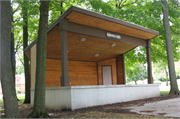Property Record
2200 WASHINGTON ST
Architecture and History Inventory
| Historic Name: | CIVIC PARK |
|---|---|
| Other Name: | |
| Contributing: | |
| Reference Number: | 222734 |
| Location (Address): | 2200 WASHINGTON ST |
|---|---|
| County: | Calumet |
| City: | New Holstein |
| Township/Village: | |
| Unincorporated Community: | |
| Town: | |
| Range: | |
| Direction: | |
| Section: | |
| Quarter Section: | |
| Quarter/Quarter Section: |
| Year Built: | |
|---|---|
| Additions: | |
| Survey Date: | 2012 |
| Historic Use: | bandstand |
| Architectural Style: | |
| Structural System: | |
| Wall Material: | |
| Architect: | |
| Other Buildings On Site: | Y |
| Demolished?: | No |
| Demolished Date: |
| National/State Register Listing Name: | Not listed |
|---|---|
| National Register Listing Date: | |
| State Register Listing Date: |
| Additional Information: | 2013 New Holstein Survey results: Civic Park is comprised of the following: A large drop-sided dance pavilion (1926; AHI#222735) on a concrete footing; an octagonal refreshment stand (1919; AHI#222737); a square kitchen facility (AHI#222736) with drop siding; a small storage shelter (AHI#222738); a more recent bandstand (AHI#222734); an open-air, covered shelter (not inventoried); and recent bathroom facilities (not inventoried). The Civic Society formed with eighteen members in 1914 with Mrs. Frederick Bullwinkel serving as its first president. Its primary objective was to improve and beautify the village. In May 1914, the society met with James Griem and Alfred Hipke, owners of the Hickory Grove Stock Farm, in order to establish a public park. Known as Hickory Grove Park and located south of Holy Rosary Catholic Church, it was utilized for picnics and concerts where the Society sold refreshments to raise money to ultimately purchase the Puchner site east of Washington Street and north of Park Avenue in 1915. Civic Park was dedicated on 4 July 1916. A house on the site was moved and some simple landscaping was completed. A kitchen for a tourist camp was built on part of the site and later, a bandstand was erected. Booths for refreshments were erected, one of which was identified in 1919 as having been funded by Alfred T. Hipke and Henry Lauson. The dance pavilion was completed in 1926. In 1941, the Society turned over the park to the city. An open-air shelter has since been added to the grounds to the northwest and the original bandstand has since been replaced; however the dance pavilion and a pair of refreshment/sales stands remain and continue to be utilized for the annual city picnic, as well as for other functions. |
|---|---|
| Bibliographic References: | “Holstein To Have Park,” Calumet County Reporter, 1 May 1914, 1/2; “Open Air Concert and Picnic,” Calumet County Reporter, 2 July 1915, 1/2; “Civic Club Acquires Puchner Park,” 26 November 1915, 1/1; Newsbrief (re: refreshment stand), Calumet County Reporter, 16 May 1919, 1/5; Construction of the dance pavilion noted in “Prominent Men Expected to be at Big Picnic,” The Sheboygan Press, 13 August 1926, 7/5-6; “New Holstein Has a Playground As Result of a Civic Society,” The Sheboygan Press, 30 September 1926, 2/1-2; “New Holstein Civic Society,” in New Holstein Centennial Souvenir Booklet, n.p. |
| Wisconsin Architecture and History Inventory, State Historic Preservation Office, Wisconsin Historical Society, Madison, Wisconsin |

